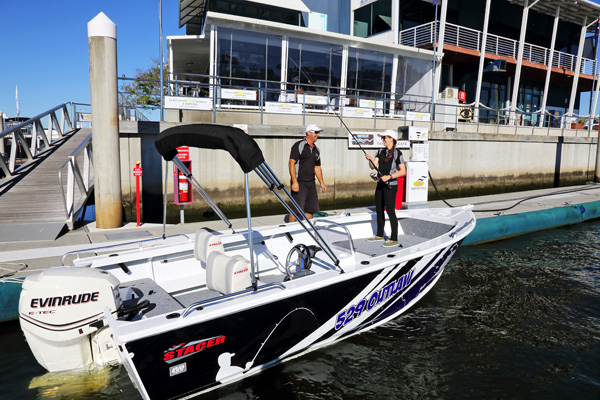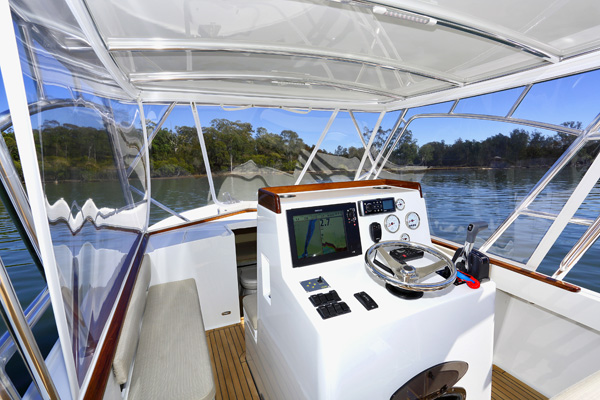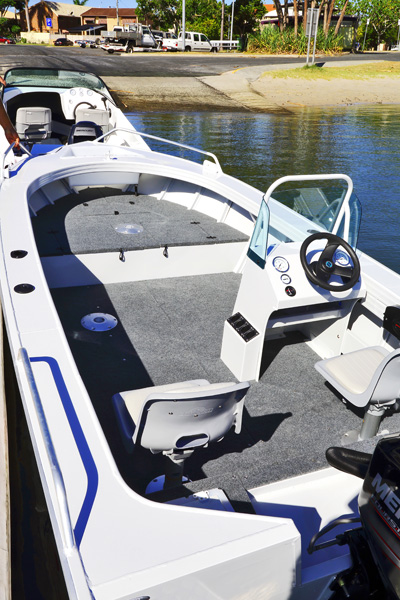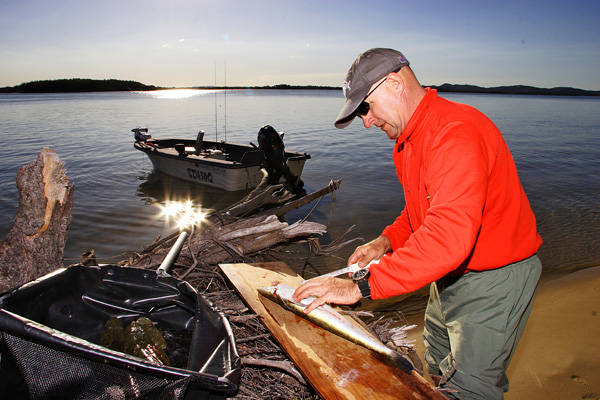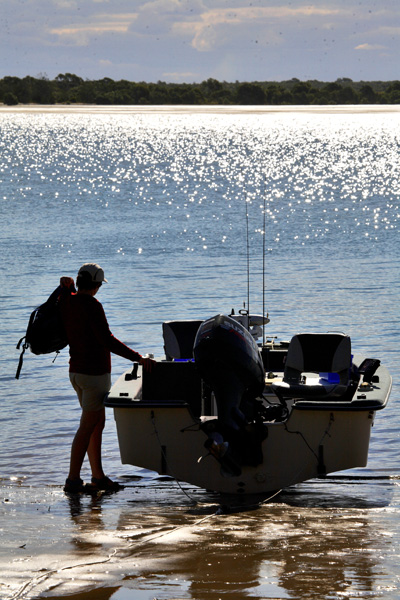JUST ONE BOAT
- NAFA
- Mar 18, 2020
- 9 min read
Updated: Apr 2, 2020
By Warren Steptoe
Boat choice usually comes down to what your boat is going to be used for. However, no boat will suit all needs; sometimes you need a second option.
If asked whether one boat was enough, even given unlimited funds and, something darn near as hard to achieve, unlimited time to fish, most of us would have to answer no. There are just too many different types of fishing out there to sample and enjoy. So, from bluewater to the headwaters, there’s no such thing as a single boat that can fish it all. Nor for that matter, enough time in one lifetime , as I found out.
A few years back I actually owned a full on bluewater sportfishing boat (a 6 metre Cairns Custom Craft catamaran,) a well set up enclosed water boat (a Savage Jabiru,) and a canoe for water too skinny and/or tight for any kind of powered boat at all. Yet even a self-employed person with a demonstrable need to be out fishing as much as possible couldn’t do all three justice. There simply weren’t enough hours in a day.
Now I’m back to an enclosed water boat with a hull that handles rough water better than most boats its size, and a battered canoe that’s probably getting past time for an update before the terrible beating it’s endured for over a decade gets the better of it. And I’m still struggling to find enough time to fully utilise both my fishing watercraft; I suppose a canoe is not a boat.
Finding time to fish is a personal thing, as varied as we who fish, and there’s nothing I can say in a publication to help much. However, it is worth discussing are the various options available in fishing boats. Watercraft is probably a better word again, because we have more choices than ever before, including a few options that are either fairly new, or not as well-known as they might be if more people knew about them.
We all have differing preferences in fishing, and different fishing options available, which leaves us with two difficult choices: First, deciding what type, or more accurately perhaps, blend of types of fishing, we might choose to apply the time we have available to fish. Second, deciding what boat, or combination of boats (again for many of us watercraft would probably be a better word), might offer sufficient versatility to make the best of the opportunities we have.
The still burgeoning kayak fishing scene is the main reason I keep saying watercraft. A ‘yak or canoe is an exceptionally good and cost effective way of expanding your fishing horizons beyond a single boat when there’s an opportunity to fish from one.
I’ve tried ‘yaks and am back with a Canadian canoe for several reasons including lighter weight portaging and dragging between pools, their ability to carry bigger payloads on multi-day downriver drifts, and a preference to fish with a companion, although at twin ‘yak belies that one. Where ‘yaks are superior to Canadian canoes, and I am talking the popular sit on ‘yaks rather than enclosed kayaks, is on rough and, usually, open water.
Obviously this sentiment hardly applies to sea kayaks, of which there are fewer suitable to fish from than there are sit-on type ‘yaks available, and even fewer enclosed deck sea kayaks are designed for fishing. Whether single or double occupancy, there’s no shortage of choice in sit on ‘yaks nowadays; they’ve become highly specialised, and some of them are good enough to be a viable choice as the only fishing boat.
And my Canadian was superior for upstream fishing and long distance downriver drifting.
In acknowledging the value to be gained from a boat and canoe/’yak combination, the only comment I feel the need to add here is that in my view, too many people who might be better served by another type of canoe, have blindly followed the amazing trend towards sit on ‘yaks. Admittedly I’m biased, I had one of each at one stage and made a conscious choice to sell the ‘yak because my boat could do virtually everything it could do; fishing southern Moreton Bay principally, only better. And my Canadian was superior for upstream fishing and long distance downriver drifting. Goodbye ‘yak although my choice will, I expect, be a different one to many other people.
What boat to combine with a watercraft becomes a good question when faced with a choice? Largely the choice should be dictated by the fishing available. From there the combinations are worth contemplating.
A major consideration at this point is whether the boat is destined for exclusive fishing usage, or is expected to fulfil other roles such as family and social boating, or some other on water activity. Towing wake toys, social (or serious) skiing are two quite a few people who fish also enjoy, albeit usually incorporated into family or social boating.
For people fishing big bays and bluewater, the classic Aussie cuddy cab was developed to fit into the dual role of offshore/big water fishing boat, and family/social boat. There several iconic brands that fit this role extremely well. They’re even quite useful as wake toy and social ski boats if required.
When optioned with a Bimini top and clears filling the gap between Bimini and windscreen, Aussie cuddy cabs offer a high degree of bad weather comfort. Any of the hardtop versions currently being released by major players in fishing/family cuddy cabs are even better in this respect. The degree of security they provide in inclement weather tends to be seen by partners as a deciding point in favour of approving financial arrangements.
Open water fishos with little interest in a canoe or ‘yak can be well advised to settle for an Aussie built cuddy cab as their only choice.
Cuddy cabs are well set up as offshore/big water fishing boats, or at least are for the right brands. A cuddy cab combined with a ‘yak or canoe covers an awful lot of water, and with a careful choice to fine tune the combo for local water, can definitely have the keenest fisho well set up indeed.
Open water fishos with little interest in a canoe or ‘yak can be well advised to settle for an Aussie built cuddy cab as their only choice.
Before moving on from cuddy cabs, I’d be remiss if I didn’t make the point that while this segment of boating has long been a real stronghold of glass hulls, the development of advanced aluminium hulls by the likes of Quintrex and Stacer have made some of the big tinnies a better choice than ever.
Once upon a time, plate aluminium hulls were the only alternative to glass open water fishing boats. Yet, while they have advantages, such as a hull capable of withstanding bad roads and bad ramps, and the satisfaction of a boat tailored to your specific requirements, these have long had to be traded off against a rough water ride with little in its favour by comparison with one of several glass boats with decisively superior rough water handling.
The Quintrex stretch-formed, Millennium Blade hulls and Stacer’s variable-deadrise stretch-formed Evo Advance hulls ride rough water well, and their layouts leave little to be desired.
You’d be a mighty pedantic customer not to find something in these two ranges as close to what you want as practicality dictates. If you’re that pedantic, you’ll probably choose a plate hull simply because it can be configured precisely how you want it.
As a boat fanatic, one development in boats over the last few years in particular I find absolutely intriguing is the way what I’ll call barra bass and bream boats have spread their wings towards open water fishing.
AJ’s original concept for the Top Ender that spawned the genre was a 4.3 metre, tiller steer with a casting deck in the bow. Now we see boats of 6m and more, with casting decks and bow mounted electric motors, being used for barra fishing, but are more than capable of venturing a long way onto open water.
How much these monsters compromise their agility up a creek somewhere with the ability to run offshore chasing reefies or even billfish brings potential owners hard up against the kind of choices inherent in boating everywhere. The point that few of us wouldn’t be better off, all else aside, with more than one boat comes home to roost right about here.
One thing I find encouraging about the BBB boats on offer from several brands are the variations available at the transom. One school of thought prefers what can only be termed a cockpit aft of (usually) a side or centre console, another goes for a stern casting deck, and yet another goes for both by having a rear cockpit but with a transom that can be stood upon, with good balance, thus doing the job of a rear casting platform.
A stern casting deck makes room to lure cast from both ends, while cockpit versions work better for trolling and bottom/reef fishing from the aft section of the boat.
The common sense displayed is encouraging, however, while casting deck/cockpit options have become rational, that same common sense seems to go out the window in between.
Cockpits usually come with a side deck high engine mount, or the motor on a pod or extended transom. This adds significantly to open water safety by increasing freeboard in a vulnerable area of any boat (in following seas.) While stern casting decks tend to be associated with a lower cut away engine mount, and the deck extending all the way to the transom to increase the deck space available to stand on and cast from.
The common sense displayed is encouraging, however, while casting deck/cockpit options have become rational, that same common sense seems to go out the window in between.
I despair Fred Average Boatie will ever learn how to trim a boat properly, or ever realise how much better the worst boat performs when it is trimmed properly. These sentiments aren’t only applicable to fore and aft trim, and the oft misunderstood trim’n’tilt switch either. Choosing between a side and a centre console isn’t straightforward for many people, but surely distributing weight inside a boat to get it sitting level, both fore and aft and sideways, regardless of whether the helm is set on one side or in the middle, is a fundamental skill every boatie needs to learn. It affects how the boat’s going to ride, and other hardly less important things like fuel efficiency and steering response. Such matters don’t have to be taken far to become real safety issues.
Nevertheless, after that rant the popularity of side consoles really could, probably should, be rethought by people who buy one without giving much thought to how many people they usually fish with, and where to place them when travelling and fishing. In the north, lengthy trips to fishing spots are the norm and they’re a perfect example of what’s to be gained by a considered choice of seating configuration.
Not to unduly knock side consoles because it’s a great configuration for a lot of people, but centre consoles still have a few points in their favour. Is it better to have the steering wheel in the centre of the boat or to one side? Sometimes, for some people, central steering is decidedly better; sometimes the balance achieved by the helm on one side and a single passenger balancing them on the other can be a better choice.
How many people do you usually go boating with? Does the boat’s layout allow different seating positions to compensate for differences in passenger weight?
One thing I don’t like about side consoles might well be why so many people like them, and that’s that you’re usually, if not quite always, seated at the helm.
Sometimes I prefer to stand up in boats. It allows me to bend my knees to reduce the bangs and bumps of a rough trip, and places the helm’s eye line higher where vision into the water around the boat is vastly improved. The better to avoid shallow water, reefs, snags, and other obstructions invisible, or at least harder to spot, from a seated position.
Such considerations can and should affect decisions about maximising a boat’s versatility against fishing options. To ask more pertinent questions: would a centre console make open water travel more comfortable without seriously compromising a boat as a lure casting platform if, for example, you have a big bay and an estuary that narrows down to snag fishing opportunities? Or is a side console going to be easier to trim, and more comfortable during hour plus runs to fishing spots?
The only concession advisable here might be a Bimini top, and if choppy wet conditions are common where your family boating is planned, some other shelter.
And, preceding discussion aside, is a side or centre console unsuited to the dual family/fishing role so many people face? The answer to this one is no way. Many people, the writer included when my kids were young, find a centre or side console acceptable for family boating, and all it takes for them to be replete as a fishing boat is a powerful electric motor mounted on the bow.
The only concession advisable here might be a Bimini top, and if choppy wet conditions are common where your family boating is planned, some other shelter.
Sure, additions such as shelter for the family like this don’t come cheap and can jack up an investment to breaking point. However, something to shelter the family that’s set up so it won’t interfere with serious fishing can be a wise investment, and will be cheaper than another boat.
While discussing fishing boats usable for family boating, another trend evident of late that I find intriguing is the way bow riders with a removable casting deck in the bow lounge seem to fallen out of favour. As a compromise between a serious fishing boat and a family boat with a fair degree of shelter, comfort, and even style, bow riders still have as much going for them as they ever did. But, after being enthusiastically embraced by the boating industry only a few years back, the casting deck option for bow riders seems to have disappeared off the radar.
What a shame. A well thought out bow rider was, and still could be, a versatile choice as the one fishing boat a lot of people can afford, especially if supplemented by a canoe or ‘yak.






